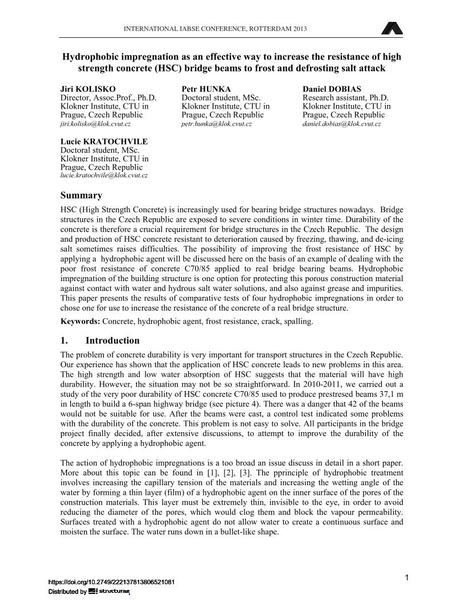Hydrophobic impregnation as an effective way to increase the resistance of high strength concrete (HSC) bridge beams to frost and defrosting salt attack

|
|
|||||||||||
Bibliographic Details
| Author(s): |
Jiří Kolísko
Petr Hunka Daniel Dobias Lucie Kratochvile |
||||
|---|---|---|---|---|---|
| Medium: | conference paper | ||||
| Language(s): | English | ||||
| Conference: | IABSE Conference: Assessment, Upgrading and Refurbishment of Infrastructures, Rotterdam, The Netherlands, 6-8 May 2013 | ||||
| Published in: | IABSE Conference, Rotterdam, May 2013 | ||||
|
|||||
| Page(s): | 464-465 | ||||
| Total no. of pages: | 8 | ||||
| Year: | 2013 | ||||
| DOI: | 10.2749/222137813806521081 | ||||
| Abstract: |
HSC (High Strength Concrete) is increasingly used for bearing bridge structures nowadays. Bridge structures in the Czech Republic are exposed to severe conditions in winter time. Durability of the concrete is therefore a crucial requirement for bridge structures in the Czech Republic. The design and production of HSC concrete resistant to deterioration caused by freezing, thawing, and de-icing salt sometimes raises difficulties. The possibility of improving the frost resistance of HSC by applying a hydrophobic agent will be discussed here on the basis of an example of dealing with the poor frost resistance of concrete C70/85 applied to real bridge bearing beams. Hydrophobic impregnation of the building structure is one option for protecting this porous construction material against contact with water and hydrous salt water solutions, and also against grease and impurities. This paper presents the results of comparative tests of four hydrophobic impregnations in order to chose one for use to increase the resistance of the concrete of a real bridge structure. |
||||
| Keywords: |
concrete crack frost resistance spalling hydrophobic agent
|
||||
